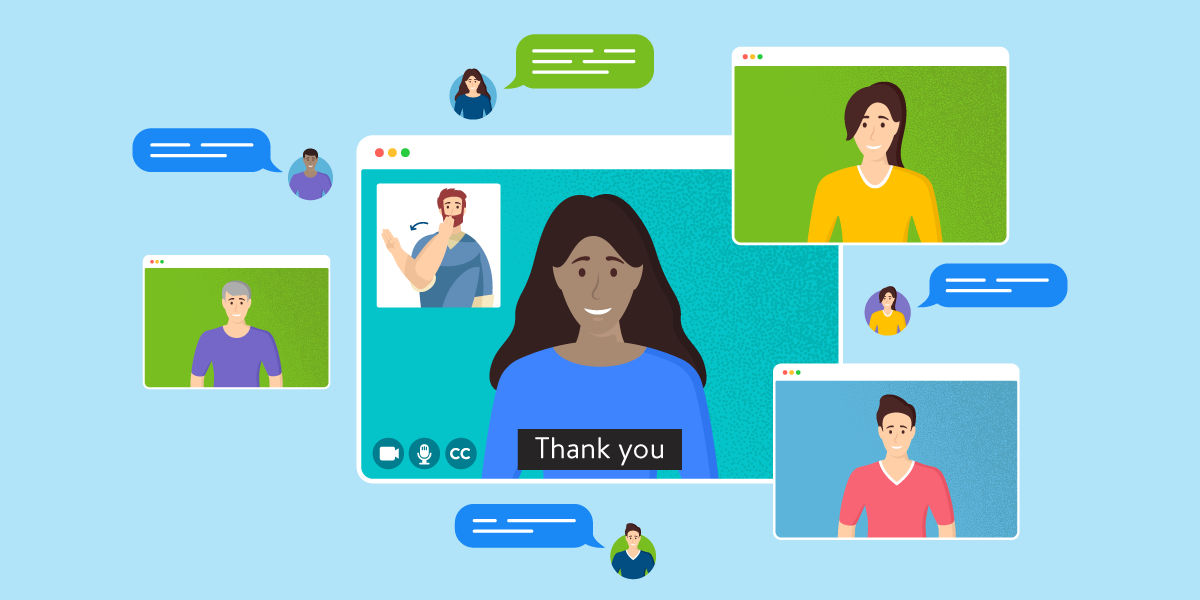Tips on making your conference inclusive
1/26/2022 2:30:00 PM

By: Jay Wyant, Office of Accessibility
Conferences are a great way to:
Event organizers and vendors have responded to the pandemic by creating virtual conferences that attempt to fulfill those same goals.
Virtual conferences are a great opportunity to ensure full inclusion. Some people with disabilities cannot travel to conferences. Others may have difficulty with group conversations or asking questions at live events. Virtual conferences can help overcome those barriers.
However, if inclusion isn’t designed into the virtual conferencing system, it may unintentionally:
We asked some of our digital accessibility coordinators for their advice to conference vendors and organizers on how to ensure accessible, fully inclusive events.
Everyone’s first answer is, “Follow the Web Content Accessibility Guidelines 2.0 Level AA (and for US vendors, Section 508) guidelines.” Better yet, follow WCAG 2.1 Level AA even if it isn’t officially required by some organizations.
Oftentimes a company or an organization new to accessibility doesn’t know where to start. They may need to have a better understanding of how their work impacts other users.
Consider accessibility from the start when you design and planning your conference, Rita Williams-Larson, Digital Accessibility Coordinator for MNIT Partnering with Minnesota Pollution Control says, “Use experts with practical experience and training in accessibility.” That includes both technical experts and people with disabilities. If you’re buying a conferencing tool, include your experts when evaluating potential vendors.
Virtual conferences can be incredibly complex. In addition to live presentations and slides, many also offer features that include:
An easy way to support accessibility is to ensure that users can access all these features and functions without a mouse. Test using basic keyboard functions such as tab, spacebar, and enter key to sign in, select activities, and navigate through all functions. Systems that support full keyboard use are much more inclusive.
As Lolly Lijewski, Human Services’ Digital Accessibility Coordinator noted, “Make sure the platform is accessible from start to finish. From registration to evaluation.”
People attend virtual conferences in all sorts of ways, from phones to multiple large monitors. Some of them will need to zoom in or use screen magnification software to read text or operate controls. Conferencing systems need to include key features such as:
After that, according to our digital accessibility coordinators, we can separate the most common accessibility fails at conferences into systems and operations:
Suppose you’ve done everything you can to buy or build a world-class conferencing platform. Now you’re running a conference. You have speakers selected and scheduled. How do you make sure everything goes as expected? In a word—practice.
Anne Sittner Anderson, Digital Accessibility Coordinator for the Commission of Deaf, Deafblind and Hard of Hearing says, “Host prep meetings with organizers, those who are running the platform, and the CART provider to ensure the equipment is compatible and works successfully. Agree on who is doing what role and task, and make sure everyone has the equipment they need for a successful conference.”
Accessible technology is only part of the solution. Conference organizers need to plan for, practice, and use inclusive best practices.
What’s different about running a hybrid conference with both in-person and virtual attendees? Our coordinators noted several key challenges:
Virtual conferences are at the leading edge of digital technology. Many conferences are already using augmented reality (AR) tools, such as virtual rooms with avatars for attendees. As demand for online conferences grows, vendors are exploring more ways to simulate the live experience. For example, combining aspects of virtual reality (VR) and AR to create three-dimensional rooms, the ability to use VR headsets, and more. There are no specific accessibility guidelines for these environments, but they must still be accessible for all participants.
Virtual conferences are a complex challenge to design and plan even without accessibility. A short newsletter article cannot cover everything you need to know. If you don’t have accessibility experts and people with disabilities in house, consider contracting for those resources. Then make sure you involve those resources in every aspect of the project – from “Welcome” to “Thank you for attending.”
Engaging and accessible social media
Accessible best practices for using chat in online meetings
Would you like to learn more about the accessibility work being done by Minnesota IT Services and the State of Minnesota? Once a month we will bring you more tips, articles, and ways to learn more about digital accessibility.
Accessibility
Accessibility